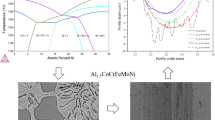Abstract
A computer program has been developed which simulates the cyclic oxidation behavior of materials. The simulation is based on the assumption that the weight fraction of scale that spalls in any thermal cycle is proportional to the amount of scale present on the surface at the beginning of the cycle. The program provides plots as well as tabular data which describe the cyclic oxidation behavior of a given material. Individual input parameters can be selectively altered and the resulting change in cyclic kinetics determined, allowing the user to quickly survey a wide range of cyclic conditions on the kinetics of a given material.
Similar content being viewed by others
References
C. Wagner, Chem. Reaktionen Der Metalle, Akao. Verl. Ges., Leipzig (1940).
K. Hauffe, Oxidation of Metals, Plenum Press, New York (1965).
James L. Smialek and Gerald H. Meier, “High Temperature Oxidation,” Superalloys II, C.T. Sims, N.S. Stoloffand W.C. Hagel, Eds., John Wiley and Sons, New York (1987).
O. Kubaschewski and B.E. Hopkins, Oxidation of Metals and Alloys, Academic Press, New York (1953).
P. Kofstad, High Temperature Oxidation of Metals, John Wiley and Sons Inc., New York (1966).
D.L. Douglass, “Exfoliation and the Mechanical Behavior of Scales,” Oxidation of Metals and Alloys, D.L. Douglass, Ed., American Society for Metals, Cleveland (1971).
C.E. Lowell, J.L. Smialek and C.A. Barrett, “Cyclic Oxidation of Alloys,” High Temperature Corrosion, NACE-6:219 (1983).
Additional information
H.B. Probst received his Ph.D. in metallurgy from the Case Institute of Technology in 1959. He is currently chief scientist, Materials Division, NASA Lewis Research Center in Cleveland, Ohio.
C.E. Lowell received his B.S. in metallurgy from the Case Institute of Technology in 1957. He is currently deputy chief, Materials Division, NASA Lewis Research Center in Cleveland, Ohio.
Rights and permissions
About this article
Cite this article
Probst, H.B., Lowell, C.E. Computer Simulation of Cyclic Oxidation. JOM 40, 18–21 (1988). https://doi.org/10.1007/BF03257976
Published:
Issue Date:
DOI: https://doi.org/10.1007/BF03257976




